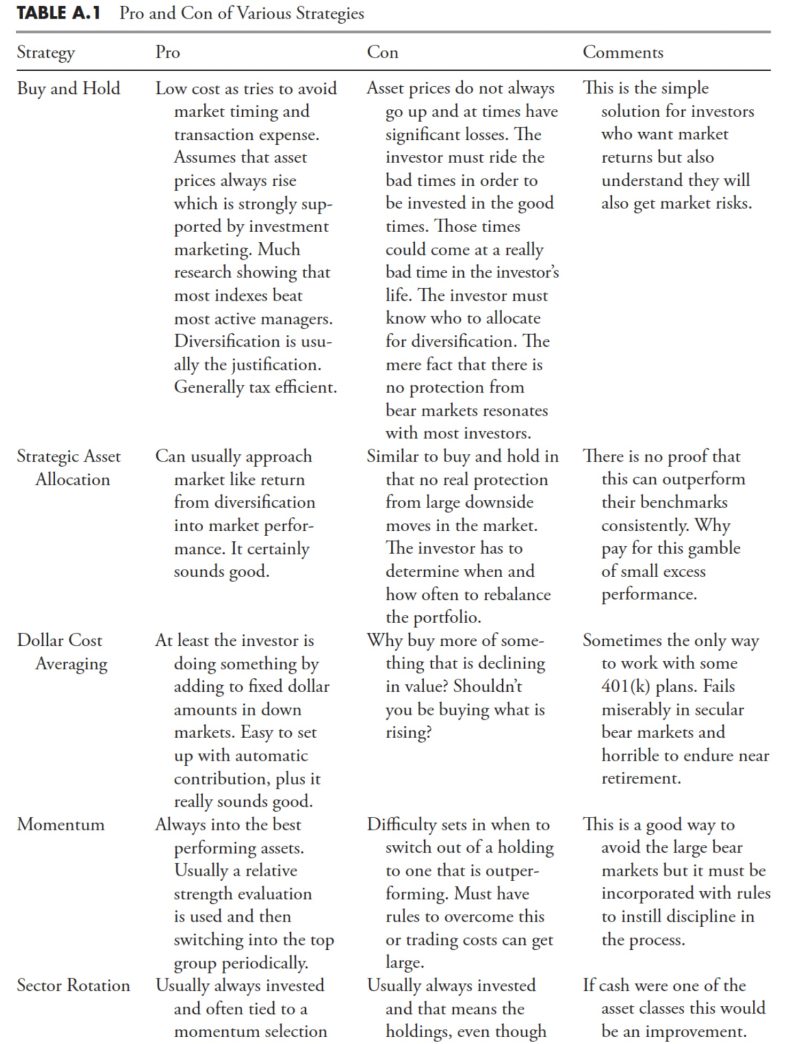June 14, 2024
Riding the Market Wave: Appendix on Trend Investing
 Appendix
Sample List of Trend-Following Indicators:
1. Moving Average: Moving averages are one of the simplest and most commonly used trend-following indicators. They smooth out price data to identify the underlying trend direction. Common moving averages include the simple moving average (SMA) and the exponential moving average (EMA).
2. Relative Strength Index (RSI): The RSI is a momentum oscillator that measures the speed and change of price movements. It oscillates between 0 and 100 and is typically used to identify overbought or oversold conditions in the market.
3. Moving Average Convergence Divergence (MACD): The MACD is a trend-following momentum indicator that shows the relationship between two moving averages of a security’s price. Traders often use the MACD to identify changes in the strength, direction, momentum, and duration of a trend.
4. Bollinger Bands: Bollinger Bands consist of a simple moving average and two standard deviation bands above and below the moving average. These bands expand and contract based on market volatility, providing traders with a visual representation of the current trend's strength and potential reversal points.
5. Ichimoku Cloud: The Ichimoku Cloud is a comprehensive indicator that provides information about support and resistance levels, trend direction, and momentum. It consists of multiple lines that help traders identify potential entry and exit points based on the cloud's position relative to the price.
6. Average True Range (ATR): The ATR is a volatility indicator that measures the average range between a security's high and low prices over a specific time period. Traders use the ATR to gauge the security's volatility, set stop-loss levels, and determine position sizes.
Sample Trend-Following Trading Strategies:
1. Trend Continuation: In this strategy, traders aim to enter positions in the direction of the existing trend. They may use trend-following indicators such as moving averages, MACD, or Ichimoku Cloud to confirm the trend's strength and potential continuation.
2. Breakout Trading: Breakout traders look for instances where the price breaks above or below a significant support or resistance level. They typically wait for a confirmed breakout before entering a position and use stop-loss orders to manage risk.
3. Moving Average Crossover: This strategy involves using two moving averages of different time periods (e.g., 50-period and 200-period SMA) and entering a trade when the shorter-term moving average crosses above or below the longer-term moving average.
4. Support and Resistance Trading: Support and resistance levels are key areas where the price tends to reverse or bounce off. Traders can use these levels to enter trades in the direction of the trend when the price approaches a support or resistance level.
5. Dual Moving Average Crossover: Similar to the moving average crossover strategy, this approach involves using two different types of moving averages (e.g., SMA and EMA) to generate trading signals based on crossovers and trend direction.
It is essential to note that while trend-following indicators and strategies can help traders identify potential opportunities in the market, no strategy is foolproof. Traders should combine technical analysis with risk management techniques and maintain a disciplined approach to investing with the trend. Understanding the strengths and limitations of different indicators and strategies can help traders make informed decisions and navigate the dynamic nature of financial markets.
Appendix
Sample List of Trend-Following Indicators:
1. Moving Average: Moving averages are one of the simplest and most commonly used trend-following indicators. They smooth out price data to identify the underlying trend direction. Common moving averages include the simple moving average (SMA) and the exponential moving average (EMA).
2. Relative Strength Index (RSI): The RSI is a momentum oscillator that measures the speed and change of price movements. It oscillates between 0 and 100 and is typically used to identify overbought or oversold conditions in the market.
3. Moving Average Convergence Divergence (MACD): The MACD is a trend-following momentum indicator that shows the relationship between two moving averages of a security’s price. Traders often use the MACD to identify changes in the strength, direction, momentum, and duration of a trend.
4. Bollinger Bands: Bollinger Bands consist of a simple moving average and two standard deviation bands above and below the moving average. These bands expand and contract based on market volatility, providing traders with a visual representation of the current trend's strength and potential reversal points.
5. Ichimoku Cloud: The Ichimoku Cloud is a comprehensive indicator that provides information about support and resistance levels, trend direction, and momentum. It consists of multiple lines that help traders identify potential entry and exit points based on the cloud's position relative to the price.
6. Average True Range (ATR): The ATR is a volatility indicator that measures the average range between a security's high and low prices over a specific time period. Traders use the ATR to gauge the security's volatility, set stop-loss levels, and determine position sizes.
Sample Trend-Following Trading Strategies:
1. Trend Continuation: In this strategy, traders aim to enter positions in the direction of the existing trend. They may use trend-following indicators such as moving averages, MACD, or Ichimoku Cloud to confirm the trend's strength and potential continuation.
2. Breakout Trading: Breakout traders look for instances where the price breaks above or below a significant support or resistance level. They typically wait for a confirmed breakout before entering a position and use stop-loss orders to manage risk.
3. Moving Average Crossover: This strategy involves using two moving averages of different time periods (e.g., 50-period and 200-period SMA) and entering a trade when the shorter-term moving average crosses above or below the longer-term moving average.
4. Support and Resistance Trading: Support and resistance levels are key areas where the price tends to reverse or bounce off. Traders can use these levels to enter trades in the direction of the trend when the price approaches a support or resistance level.
5. Dual Moving Average Crossover: Similar to the moving average crossover strategy, this approach involves using two different types of moving averages (e.g., SMA and EMA) to generate trading signals based on crossovers and trend direction.
It is essential to note that while trend-following indicators and strategies can help traders identify potential opportunities in the market, no strategy is foolproof. Traders should combine technical analysis with risk management techniques and maintain a disciplined approach to investing with the trend. Understanding the strengths and limitations of different indicators and strategies can help traders make informed decisions and navigate the dynamic nature of financial markets.
If you would like to delve into the world of investment topics , go to our partner project Wall Street Wizardry


